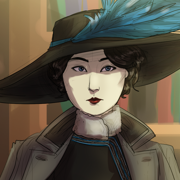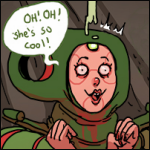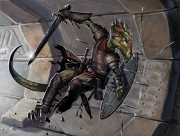|
Plenty of nerding out so far. I don't know nearly as much about the Aztec cultures as I do about the Maya and Peruvian ones, so I'll not talk any about the most bloodthirsty bastards that side of the ocean. I'm gonna focus on my favourites, the Inca and their predecessors. Pacho posted:[Snip on a bunch of stuff about OTL Inca] In Tibet's timeline an ambitious ruler around 500-600 AD could have used his soft power to strengthen Tiwanaku's influence in some way or form to bring the various citystates and petty kingdoms into a loose-ish alliance with one high king. If this happened, we could have things like a thriving Nazca people. The Wari people were fairly influential at the time as well, probably in a coalition with the coastal states of the time. They'd likely play the counterweight to Tiwanaku's influence, kind of like a Prussia-Austria situation but trying to gain political superiority through diplomacy rather than outright warfare. There most likely were plenty of raids from more nomadic tribes and cultures forcing them to keep playing nice with each other. In a nutshell, militaristically strong Wari versus cultural/religious powerhouse Tiwanaku with dozens of minor to medium states all vying to be the Big Kahuna is the most likely scenario right now, in Peru. Polynesian colonisers or Peruvians colonising into Polynesia is feasible, if kind of unlikely? The distances involved are significant, though it'd be more likely for Polynesians to visit and potentially establish a city-state in the north, near the modern Peru-Ecuador border. Isla Puná and surrounds would be an ideal location, potentially. Galapagos could be a 'pit-stop' for them.
|
|
|
|

|
| # ? May 29, 2024 03:22 |
|
Sunset Invasion absolutely has an event that takes the plague back across the ocean.
|
|
|
|
More nerding out on north mesoamerican worldviews. Sacrifice. This is the big, important thing. In the worldview of mesoamerican cultures, there is a concept known as the "flower-death." You are supposed to die in the prime of your life. Living old isn't a sign of being wise, it's a sign of being a coward who chose the easy way out of dying of old age. In order to survive the afterlife, you need to die in one of three ways: war, sacrifice or childbirth. War and childbirth are not just considered equivalents for men and women, by the way, they are considered to be literally the same thing as the act of childbirth is considered to be fighting to tear someone from the realm of death into life as the act of war is the opposite. Deaths that weren't one of the three were graded pretty much infinitely. At the bottom of the hierarchy of death and afterlives were old age and disease, the more relatively painless the death, the worse of a person you are. Why this is comes down to the idea of energy in their religious worldview. Much like the second law of thermodynamics, Mexica and their related cultures believed that there is a finite amount of energy in the cosmos that cannot be created or destroyed. In order for the world to keep in motion and avoid destruction this energy must be transferred. The bodies of men were to feed the earth to bring forth new life, but their souls to feed the heavens to sustain the gods. Therefore, sacrifice was considered to be the most worthwhile death. It was never a punishment, but always a reward. You were supposed to avoid being captured, of course, but showing fear at the sacrifice, enough to try to run was thought to be the worst and most taboo kind of act in existence. Most sacrifices weren't captives, though. Mostly they were part of various festivals and celebrations or other cyclic rituals. Part of this includes the sacrifice taking on a godly mantle in costume and acting in character, during which they were believed to literally be an avatar of the god in question. So when depicting sacrifice from mesoamericans, it's important to note that while they might be afraid of the pain, the act is always a positive one. Returning one's life to the gods upholds the order of the cosmos and keeps it from collapsing. Doing this is always a moral thing and to face it with bravery is a display of supreme and upstanding character. The act has to be painful because otherwise it has no meaning, a peaceful death is a worthless life.
|
|
|
|
Hadn't noticed this one until now. Looks nice, I'll have to get caught up. Also cool that it it's in a part of the map that often gets overlooked (though I am of the opinion that India in EU4 is one of the more fun playgrounds on that entire map). I'll have more to say after I've read up on this. Alongside having waited for a compatability update for the mod I was using (which took weeks longer than I expected) various real life events left it inconvenient for me to update my own Central Asian LP since April (a wedding, a funeral, among others), but with things having settled somewhat I was actually looking to getting back to it this week and getting an update out as soon as possible.
|
|
|
|
This is already one of my favourite CK2 LPs. Keep it up Kangxi!
|
|
|
|
Sampatrick posted:That's rad. Are there any books you recommend for learning more about what Inca society and governance looked like? I recommend History of the Inca Realm by Maria Rostworowski, there's an english version at Amazon
|
|
|
|
First, thank you for all the nice comments and even more for the effort posts. I know nothing substantial about that part of the world in this time frame, so I've already learned something going over these. Would you mind if I linked to one or two in the table of contents so later readers have a link to the conversation? Anyway, if I don't finish my update by tonight, expect it probably by some time next week. I'll be out of town visiting family friends.
|
|
|
|
NewMars posted:Maya, who were able to establish a federation of city-states that dominated the entirety of the Yucatan peninsula, before it horribly imploded due to succession issues and rebellion. Man that CK2 player must've been pissed when that happened. Sounds pretty fitting to just put in Eu4.
|
|
|
|
ChaseSP posted:Man that CK2 player must've been pissed when that happened. Sounds pretty fitting to just put in Eu4. It's already in EU4, actually! It's the base start of the game that it begins just after the league of Mayapan imploded and you start as one of the sucessor states with a decision to reform the league once you reform your religion. Kangxi posted:First, thank you for all the nice comments and even more for the effort posts. I know nothing substantial about that part of the world in this time frame, so I've already learned something going over these. Would you mind if I linked to one or two in the table of contents so later readers have a link to the conversation? I would be totally cool with this!
|
|
|
|
So I did some reading and wow Mesoamerica is seriously late to the metallurgy game. The earliest signs of it come from Peru, Ecuador, Bolivia, and northern Chile after 2000 BCE'ish, though that's just gold work which is a lot easier. It's not until the 200 BCE to 600 CE that proper smelting shows up in th Moche along the northern coasts of Peru. It takes a long time to spread from there with the techniques not really reaching Mesoamerica until the 800s CE after filtering through their southern and Caribbean neighbors. Through out all of that it's primary purpose was ornamental or wealth, which is something that I'd feel has to change here for something the scale of the Sunset Invasion to be possible let alone plausible. Of course that's going to be changed there needs to be a reason for metal to be put to practical use. It'd have to be a tool that increases agricultural productivity; one that stone or wooden tools wouldn't be able to match. The only thing that comes to mind a metal plow which did a hell of a lot for agriculture north of the Mediterranean, but without any animals to pull the thing that's kind of a moot point. If such an animal did exist though, it'd totally make it worth the investment, increased crop yields allow for increased specialization. Plus its not like there weren't creatures that could have made suitable candidates had they dice rolled differently during the end of Ice Age. The less giant sized ground sloths could make a decent candidate for such a critter, as could something like the Camelops or other new world camelids.
|
|
|
|
Kangxi posted:Would you mind if I linked to one or two in the table of contents so later readers have a link to the conversation? If you also mean my posts about the Incas, yeah, go ahead!
|
|
|
|
I just discovered this LP, and read through it over the last couple hours. I'm getting even more ahead of the game here, but if you decide to convert to Vic2, I can advise on the practical aspects of the conversion. Especially if you decide to use the converter. I know it's less popular around here than elsewhere, but if you choose to use it I can help you get it working to the best degree possible.
|
|
|
|
Rubix Squid posted:So I did some reading and wow Mesoamerica is seriously late to the metallurgy game. The earliest signs of it come from Peru, Ecuador, Bolivia, and northern Chile after 2000 BCE'ish, though that's just gold work which is a lot easier. It's not until the 200 BCE to 600 CE that proper smelting shows up in th Moche along the northern coasts of Peru. It takes a long time to spread from there with the techniques not really reaching Mesoamerica until the 800s CE after filtering through their southern and Caribbean neighbors. Through out all of that it's primary purpose was ornamental or wealth, which is something that I'd feel has to change here for something the scale of the Sunset Invasion to be possible let alone plausible. I can't remember exactly who but there were some Mexican or Yucatan peoples who did use copper for weapons and such. Specifically it was one of the people who allied with Cortés against the Aztecs, they were engaged to make lots of copper spearheads to re-equip Cortés's forces when the governor of Cuba was sent to arrest him with a force which significantly outnumbered Cortés's and included large numbers of cavalry. Randarkman fucked around with this message at 21:46 on Jul 18, 2019 |
|
|
|
Rubix Squid posted:The less giant sized ground sloths could make a decent candidate for such a critter. Oh god yes. The midsized ground sloths like Mylodon were over 1000 kg and lasted until ~5000 BCE. I don't think large animal domestication started in the new world until like 3000 BCE with the llama, but I think guinea pigs were further back than that. So if domestication kicks off earlier, you've got a potential for the functional equivalent of the aurochs or water buffalo. And that's not even talking about Megatherium and the other truly gigantic ground sloths. They were around until about ~10,000 BCE, which is (give or take a couple thousand years) when humans began the process of hunting males of a species and leaving a reproductive population. If that happens in South America, you've got the chance for them to survive as a species until they can become semi-domesticated a la the Asian and African elephants. What I'm getting at... This world needs sloxen and war sloths with bigass step temple howdahs!
|
|
|
|
habeasdorkus posted:Oh god yes. The midsized ground sloths like Mylodon were over 1000 kg and lasted until ~5000 BCE. I don't think large animal domestication started in the new world until like 3000 BCE with the llama, but I think guinea pigs were further back than that. So if domestication kicks off earlier, you've got a potential for the functional equivalent of the aurochs or water buffalo. I am sad, because I read this without confirming which bookmark i'd clicked and thought this post meant that the Caveman2Cosmos thread had updated. Looking forward to the alternate take on Mesoamerica for this particular thread's instance of the Sunset Invasion.
|
|
|
|
Speaking of step temples. What are mesoamerican step pyramids and what do they symbolize? They're literally man-made mountains. See, in the Aztec worldview all power flows down from the heaven as rivers, both literal ones and metaphorical ones. Here, the creation of a step pyramid is a mountain by which energy may flow up as a sacrifice and down as divine favor. At the zenith of the pyramid, the mountain touches the heavens, the realm of the gods.These pyramids usually weren't also made as their final height either, usually they'd start as a simple platform in a village that gets raised up as the settlement expands, with layers being built on top of it, so that the interior of an old one is a confusing labyrinth comprised of the generations of buildings it was constructed on top of. A pyramid was the most important structure in a city, capturing it signaled victory for the attackers and utter defeat for the defenders. The aztecs were very big on treating divinity as a very touchy thing. Losing favor like that was a crushing and hopeless defeat, even if you could fight them off just afterwards. Related to that, only priests could see the idols housed at the top room of the pyramid, except during sacred times when the energy of the events protected onlookers, as the energy of the gods was said to cause any who looked directly upon the idol to die instantly or be struck blind, as it was the body of the god on earth. This was not a curse, just an expected result of witnessing that much power without being trained or sacred yourself. Speaking of cities: mesoamerica was a land of cities. Everything was seen as a collection of city-states by the Aztecs. States larger than that were not a thing. States smaller than that did not exist. All villages were attacked to a city, which was the singular political unit. This was true for others such as the Maya as well. However, this was likely not true for the Tarascans, although we know little of them, they seemed to work as a centralized kingdom instead after starting out as an expansionist city state, centralizing in a way alien to the rest of the area. A city, by the way, is differentiated from a village by the presence of a proper pyramid temple as well as the presence of more than one Calpulli, which are the extended clans that made up the world of the aztecs, with equivalents among other cultures in the area. What this means in CK2 terms is that they would likely have a form of feudalism where city holdings are their primary ones, possibly with being able to hold temples like Islamic rulers as well. However, temples in a city and their precincts were the property of the priests and while the head of the empire was a very important sacral personage and so were the heads of most cities, the orders and hierarchies of priests were very separate from administrative ones. As for feudal holdings, it's quite likely they would have no idea what to do with a castle besides using it for a fort. Mesoamerican rulers dwelled in the hearts of their cities, in palace complexes, and fortified the walls of the city instead.
|
|
|
|
Rubix Squid posted:Of course that's going to be changed there needs to be a reason for metal to be put to practical use. It'd have to be a tool that increases agricultural productivity; one that stone or wooden tools wouldn't be able to match. The only thing that comes to mind a metal plow which did a hell of a lot for agriculture north of the Mediterranean, but without any animals to pull the thing that's kind of a moot point. If such an animal did exist though, it'd totally make it worth the investment, increased crop yields allow for increased specialization. Plus its not like there weren't creatures that could have made suitable candidates had they dice rolled differently during the end of Ice Age. The less giant sized ground sloths could make a decent candidate for such a critter, as could something like the Camelops or other new world camelids. Another factor that prevented large scale plains agriculture in precolumbian Peru-Ecuador, is that the fertile coastal plains (north of Lima up to Ecuador) get absolutely wrecked once every 20 years or so by El Niño. A couple of years ago we had a mini-Niño that we still haven't recovered from in our sci-fi years of the XXI century so in those times they were absolutely apocalyptic events. That why most explanations of "why this incredibly succesful coastal empire colapsed" is "A specially lovely Niño happened" and why agriculture research was mostly focused on "how can we plant on mountain slopes or the desert and maximize crop variety and productivity in different altitudes" and not "how to optimize agriculture in massive plains"
|
|
|
|
Randarkman posted:I can't remember exactly who but there were some Mexican or Yucatan peopels did use copper for weapons and such. Specifically it was one of the people who allied with Cortés against the Aztecs, they were engaged to make lots of copper spearheads to re-equip Cortés's forces when the governor of Cuba was sent to arrest him with a force which significantly outnumbered Cortés's and included significant numbers of cavalry. That was the Tarasca/Purépecha state, which was probably the biggest enemy to the Aztecs pre-Cortes.
|
|
|
|
Chapter 18: 1011 to 1019 - Tsenmo Purgyal Shonnu From the start of her reign, the Tsenmo Shonnu ordered that a copy of each of her letters be made and included in the imperial library at Lhasa. This provides an intriguing, albeit one-sided view of events in Tibet and its immediate neighbors in the early 11th century. However, to the historians' later delight, her secretaries took an expansive definition of 'letters', which includes brief messages to her court and inquiries to her staff and imperial archivists. The sometimes informal tone of the remarks indicates they may have been dictated. To Sal, my general of the army: I would like for you to tell me how many troops I can call up in a time of war, where they can be called from, and who would command them. I would need to know how they can be trained, how many can use bow and arrow, and how many can ride a horse. Let it be done. To the lonchen, Huldi Palden of Nepal: What do we now know about the new dynasty after the Jin? I have heard they're of the descendants of a man with the family name To Sal, my general of the army: Have courage, my friend. I would not lead us into some war we have no chance of winning, as you said. I have the utmost faith in them, as a mother believes in her children. With soldiers as steadfast as you at my side, defeat is impossible. To the blacksmith, Chukpo I have in my possession some older pieces of armor, likely of Jurchen craftsmanship. A few of the palace guards that came over with the old empress dowager have died and left no children. Do you think this can be used? I may sell the metal to you for scrap. I'm going to need a new set of armor anyway. None of the previous sets seem to fit me. They're all a bit tight across the chest and I can't even fit my arms into the leather braces. To the royal cook, Tsunda: What is this new vegetable I had for dinner last night? The round earth-colored ones that you put yak butter over. I ate three of them. I told you I wanted something new and I am very satisfied. The servants aren't telling me where they got it. What is it called? Where did it come from? I want to know if it can be grown here. To Sal, my general of the army: We discussed this idea previously and I understand your concerns. I know it will be difficult for the mountain country but I am convinced we will need more wheeled carts for the army for the transport of food, bundles of arrows, heavy ammunition, and grass for pack animals. We will need them built. To Udumsten: XXXXXXXXXXXXXXXXXXXXXXXXXXXXXXXXXXXXXXXXXXXXX [This letter is left untranslated as an exercise for the reader.] To the empress dowager Your majesty: I have sent some books I have purchased. Enclosed, you will find a Jurchen dictionary, believed to have been written at the Hanlin Academy, most of The Biographies of Exemplary Women, and a new illuminated edition of The Life and Works of Gyalyum. You may keep them, or they may be sent to the imperial library that you run now. To the empress dowager I was mistaken to have not regarded your dreams. This was clearly a message from a supernatural power. To Chukpo, the blacksmith Accept payment for services rendered. To Sal, my general: I will soon discuss my plans with the vassal kings. We advance south against the Pala. Our goals should be to take the lands around the city of Gauda, as far north as Kotivarsha and the land of Raḍha. To Dagmo, crown princess: My dearest daughter: I am sorry that I have spent this time away from you. Please find enclosed an account of my military campaigns in the south, and what I have seen and heard there. Our forces are victorious and I can predict a rapid end to the war. I go to war eagerly, I do admit it, but it is the task of royalty. I do my work with attention and care as I do anything else. I do this duty joyfully with the expectation of a divine reward. It is to guarantee the security of our family and this kingdom and to carry out the dictates that were established by our esteemed ancestors. I once talked to the empress dowager about duty and one's station in life. She looked at me, right in the eye, with the kind of look an antelope has right before you spear it, and said 'Heaven and earth are inhumane, and regard all living things as straw dogs.' There's some meaning in that riddle. I once tried to read through some of those sacred texts of hers but they made barely any sense. In any case, please write back to me soon. As you know, I am so proud of you. To my brother, Tsendro: You asked for more news about the war so here it is. The eastern half of Gauda fell after a brief siege. We pursued the enemy to Ramavati(OOC: I could not find this location) and destroyed them. This was shortly before the death of the 'Han emperor', in 1014 CE. I then pursued the enemy northwest to Kotivarsha, and then I defeated them there. It was there that I found the enemy commander, Gajnarayan, and I there I slew him. He was very sloppy, so it was not that difficult. That battle was enough to convince the Pala to admit their defeat. I wish you success as part of your new governorship. I had the easy part; it will be harder to put it back together again. I believe in you. I will soon be off to campaign against Loulan. I hope to recover that city as well as Yuni and Ruoqiang. I am rested well and ready for the coming battles, And will soon make ready to move into the new lands as well as establish border posts at the nearby desert. I have a suitable candidate in mind. On a final note, please send greetings to Gyimsheng. To the lonchen, Huldi Palden of Nepal, and to the general Sal: I am extremely concerned over the Pratiharas. They have moved passed the Indus mountains, and into other valleys, into Persia and almost to the Oxus. They have taken Merv and Nishapur. I have heard wild rumors about Dehanagadevi and her evil. While some of these are rumors, I wonder how many of them are true. We must discuss a plan to contain her. I propose we move against the Cumans and take the Fergana Valley, and prevent her from acquiring it. We will meet on this discussion later, I look forward to hearing what you have to say. To the empress dowager: I thank you for having come to my aid so quickly. It was not a problem with the campaign, as you know. I cannot understand why they decided to attack us in the mountains, for what it is worth. Or even to make the same mistake again. That was not the issue. The problem is that I have been having terrible headaches. Those herbs you've suggested that I burn have made my tent more comfortable. The war has come to a decisive conclusion and we can soon expect control of the entire valley. But I have not been so well. I've had fever dreams. The fever is gone now but I've been thinking about one dream too much. I've heard you know about dreams so I'm asking you. I know you told me cultivated and disciplined people don't have dreams but they could also be messages or instructions. Could you help me understand it? I dreamed that a saw a woman in armor. She had a helmet like mine and a long sword. I could not see her face as she was on the floor kneeling. When I approached and called her name, she rose and said asked me about life and death. Whatever I said did not satisfy her, so she pulled out a knife with a triangular blade and cut me in the heart. I fell down, and she only looked at me and said that the old gods are soon retiring, that all shall be blessed receive nothing, and that every treasure shall soon be corrupted by the touch. I told her that I'm still alive, I don't have to listen to what you say. She laughed at me, and her laughter was like the clatter of dried bones. I am grateful for what you'd have to say. Kangxi fucked around with this message at 02:18 on Jul 19, 2019 |
|
|
|
Well, the Mongols had to arrive eventually I suppose. Hopefully they focus on going West.
Eleven Eleven fucked around with this message at 01:24 on Jul 19, 2019 |
|
|
|
Pacho posted:Another factor that prevented large scale plains agriculture in precolumbian Peru-Ecuador, is that the fertile coastal plains (north of Lima up to Ecuador) get absolutely wrecked once every 20 years or so by El Niño. A couple of years ago we had a mini-Niño that we still haven't recovered from in our sci-fi years of the XXI century so in those times they were absolutely apocalyptic events. That why most explanations of "why this incredibly succesful coastal empire colapsed" is "A specially lovely Niño happened" and why agriculture research was mostly focused on "how can we plant on mountain slopes or the desert and maximize crop variety and productivity in different altitudes" and not "how to optimize agriculture in massive plains" All the more reason to have an animal that can handle those mountains.
|
|
|
|
Mongols v. Aztecs, always a hellish situation for the Middle East and Europe. Hopefully they completely ignore you!
|
|
|
|
As I mentioned before, the Tarascans were pretty much the only Mesoamericans who knew metalworking. Them aside though, now it's time for: Potatoes and Maize. Potatoes are a vital crop. You may not realize it, but they are amazingly adaptable and nutritious compared to pretty much everything else. Not that people in Europe actually grew them once they knew of them. Spaniards in the new world refused to eat a crop so associated with the natives and basically no one in Europe would eat them for a number of reasons. First of all was that they were strongly associated with a bloodthirsty heathen civilization. Second was their resemblance to nightshade and last was the fact that they grew underground. All of this basically meant that the only wide-scale adoption of the plant for centuries was as animal fodder. When the plant was finally adopted for human consumption, it caused a population boom due to it's ease of growth, how fit it was for long term storage and nutritional value. Maize on the other hand is less adaptable and not as good for you. But, for mesoamerican civilizations, it was vital, both nutritionally and spiritually. For the Aztecs, maize was considered literally a gift from the gods and the meal of adults. To eat maize was when a child was no longer considered a child. This means that when they die they would have the afterlife of adults, instead of their soul being sent back to the heaven of children and the unborn to await rebirth, they would make the journey along the underworld like anyone else to reach a final fate. This is because Maize is a gift from the gods and to accept it is to accept your place in the endless interchange of energy that revitalizes the cosmos. One could, theoretically, not eat maize, but to do so would be immensely suspect, not to mention mark you out as a very infantalized person, who desires the life and death of a child and not that of an adult.
|
|
|
|
Maize is pretty efficient when it comes to water though and plays exceptionally well with legumes and squash. You are leaving out the importance of amaranth, which was up there with maize and chia seeds (another staple crop in the region) given it made a fair chunk of their diet and had religious significance. It also grows at speeds on par with weeds, doesn't seem to take much effort, and stores as well as maize. Plus its flowers are super pretty. Once Spain rolled in and took over they outlawed its cultivation because of its strong association with the local religions, much like they did with quinoa in the Andes. Probably why it's really only starting to make a bit of a comeback. Also it should be pointed out that the Tarascans were the ones who did practical metallurgy and had a grasp of smelting and working it . There were plenty of others who used metal but it was primarily cast using lost wax methods but what they made was for ornamental purposes or wealth. To everyone but the Tarascans it was basicly a novelty for the elites to show off their status.
|
|
|
|
The Tarascans seemed to know that what they had was exceptional in terms of metalworking, to the extent that they actually had a system of keeping the mines where the ore was extracted separate from the place where it was worked, which was also separate from the places where it was traded, so that no one could learn their secrets.
|
|
|
|
Pacho posted:Another factor that prevented large scale plains agriculture in precolumbian Peru-Ecuador, is that the fertile coastal plains (north of Lima up to Ecuador) get absolutely wrecked once every 20 years or so by El Niño. A couple of years ago we had a mini-Niño that we still haven't recovered from in our sci-fi years of the XXI century so in those times they were absolutely apocalyptic events. That why most explanations of "why this incredibly succesful coastal empire colapsed" is "A specially lovely Niño happened" and why agriculture research was mostly focused on "how can we plant on mountain slopes or the desert and maximize crop variety and productivity in different altitudes" and not "how to optimize agriculture in massive plains" Also likely why the Lowland Maya imploded during the Terminal Classic. Rulers are rulers because (among other things) they can successfully petition the gods for rain, most often through a sacrificing a bit of their blood. So when a multi-year long drought happens people start questioning the system and poo poo starts falling apart as the crops keep failing. Sacrifices, especially child ones, increase during this period, and you get more them in caves which have association with water. You start getting terminal deposits at city centers, often in prominent locations and directly on the plaster floor. Terminal deposits (also called peri-abandonment deposits) basically present themselves as huge sherd assemblages with various other artifacts and or faunal remains mixed in. Jury is still out on what they are, ideas range from ritual deposits left by people ritually terminating the site, to offerings, to the general population smashing the poo poo out of the elites poo poo, to warfare (its almost never warfare). At the end people pack up and leave and population density basically plummets, you have people still around because people dip into to abandoned sites to salvage materials and preform intrusive burials. The Puuc region up north does fairly well though at keeping its poo poo together. Also they lose the writing system and basically as far as we can tell start writing gibberish as art designs on ceramics. Your fun fact of the day is that river snails (jute) were eaten at ball court games like popcorn. A lot of snails. Like enough that jute shells were used as construction fill in their buildings.
|
|
|
|
Speaking of Ball Court Games: the Ball Game. Yes, that's what it's called. Every culture had a different name for it and every one of them played in a slightly different to radically different way across mesoamerica. Tarascans, Aztecs, Mixtecs, Zapotecs, Highland and Lowland Maya, they all played the game and it was of immense spiritual meaning to all of them. The games were played with a ball made entirely from rubber, making it extremely heavy, which means it could easily injure or even kill a player. Points were gained by hitting the ball off the opposing wall and the teams were made of 2-4 players each. To the stone ballcourt, the only significant change ever made to it was the addition of stone rings on each side of the court, with passing the ball through them being an instant though incredibly rare win. What the ball game meant symbolically is unknown, just that it was incredibly important. Being as mesoamerica is a very large and heterogeneous place, it may well be anything from a proxy of war, to symbolically representing the movement of the heavens with the ball as the sun, a renewal of the world's fertility, or even a more sort of general duality with the contest being between day and night, or life and death. A single exception to this obscurity is among the Highland Maya, who indeed saw it as a struggle between life and death and a process of renewal thereby. Specifically, in their myths the great hero twins Hunahpú and Xbalanqué played the game, enraging the lords of Xibalba, the underworld, who had killed the twin's father and uncle. The lords of Xibalba summoned them to the underworld and engaged them in trials and a contest of the ball game with the intent of killing them. However, the twins tricked and defeated the lords of the underworld, humiliating them so much that Xibalba was to no longer be a "place of greatness" and that it's lords were to be never given offerings or worship again. A somewhat obvious reading of this is that it is also a representation of older deities connected to Xibalba being replaced by newer ones, possibly imported from the lowland Maya, though, really that's just speculation from me.
|
|
|
|
Kangxi posted:
Based upon some googling, Ramavati appears to have been a major city in the 12th century, and located somewhere near Gauda.
|
|
|
|
habeasdorkus posted:Oh god yes. The midsized ground sloths like Mylodon were over 1000 kg and lasted until ~5000 BCE. I don't think large animal domestication started in the new world until like 3000 BCE with the llama, but I think guinea pigs were further back than that. So if domestication kicks off earlier, you've got a potential for the functional equivalent of the aurochs or water buffalo.
|
|
|
|
Big sloths are canon
|
|
|
|
Yes but have you considered Battle Tapirs.
|
|
|
|
Rubix Squid posted:All the more reason to have an animal that can handle those mountains. Oh yeah, absolutely, I was just pointing out how geography pushes technology in ways that might seem odd or inefficient but were just another branch of the tech tree. For instance, if in LP-timeline instead of a John Deere we get a John Taruca, there's a chance his tractors would be spider-like mechs suited for terrace farming. Also, spider-tanks
|
|
|
|
Telsa Cola posted:Yes but have you considered Battle Tapirs. Battle Llamas 
|
|
|
|
Pacho posted:Battle Llamas We are back around to Tapirs now because Gloranthia has Tapir people who ranch humans.
|
|
|
|
China just can’t catch a break this game, huh.
|
|
|
|
Red John posted:China just can’t catch a break this game, huh. Broken several times already.
|
|
|
|
I love the idea of giant sloths (and native horses) surviving in this timeline and allowing the Native Americans to develop much more rapidly. Forget about the Aztecs. We should have seen an invasion by the Compache or Iroquois.
|
|
|
|
This is anecdotal, but I'm pretty sure I read somewhere that the many domesticated animals in the Old World was the reason why the Europeans brought so many awful diseases with them, but didn't bring any (except possibly syphilis) back from the New World. Widespread animal husbandry gave animal germs many more opportunities to jump species and infect humans. What I'm saying is, if the Americas have widespread animal domestication, wouldn't they likely have their own nasty diseases waiting to spread to Europe?
|
|
|
|
Viola the Mad posted:This is anecdotal, but I'm pretty sure I read somewhere that the many domesticated animals in the Old World was the reason why the Europeans brought so many awful diseases with them, but didn't bring any (except possibly syphilis) back from the New World. Widespread animal husbandry gave animal germs many more opportunities to jump species and infect humans. One of the events in the Aztecs Arrive post mentioned that they brought over Syphilis when they landed.
|
|
|
|

|
| # ? May 29, 2024 03:22 |
|
Viola the Mad posted:This is anecdotal, but I'm pretty sure I read somewhere that the many domesticated animals in the Old World was the reason why the Europeans brought so many awful diseases with them, but didn't bring any (except possibly syphilis) back from the New World. Widespread animal husbandry gave animal germs many more opportunities to jump species and infect humans. They still wouldn't have quite as many domesticated species as the Old World so there probably aren't quite as many diseases. Still should give them an edge when the counterexchange happens.
|
|
|




























